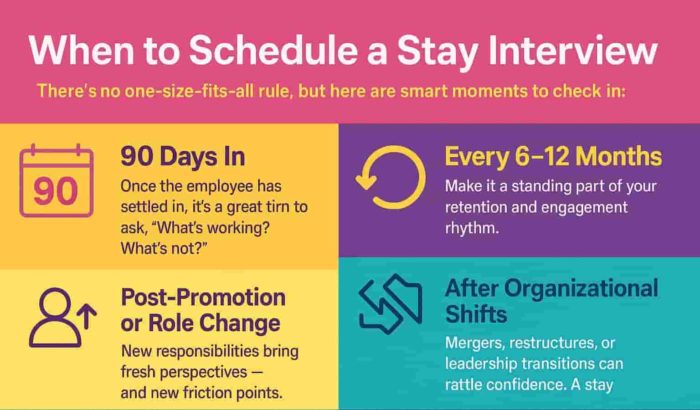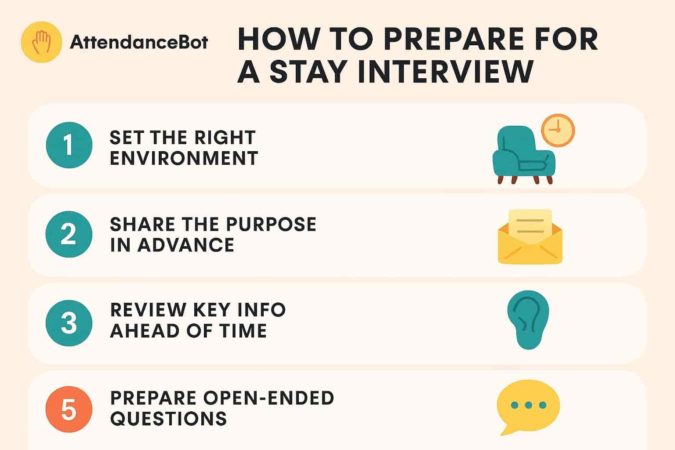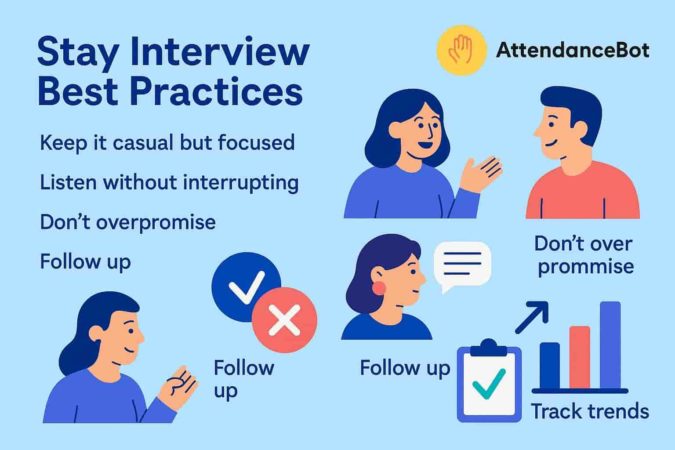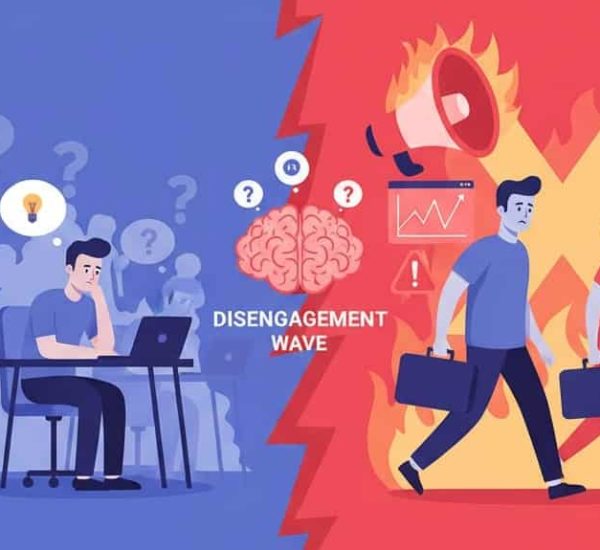What makes people stay? It’s one of the most important — and often most overlooked — questions in employee engagement. While exit interviews offer hindsight, stay interviews give you something more powerful: foresight.
A stay interview is a one-on-one conversation between a manager or HR leader and an employee, designed to understand what keeps them motivated and what might cause them to leave. It’s not about performance or KPIs — it’s about listening, learning, and acting before it’s too late.
At a time when top performers have more career options than ever, regularly asking “What can we do to keep you?” is no longer a luxury. It’s a necessity. Done well, stay interviews build trust, surface honest feedback, and help organizations strengthen retention strategies from the inside out.
In this guide, you’ll learn when and how to run a stay interview, the best questions to ask, and the common pitfalls to avoid — so your best people don’t walk out the door without warning.
Why Stay Interviews Matter
A well-timed stay interview can reveal what an exit interview never will: the thoughts, concerns, and motivations of employees before they’ve decided to leave. Think of it as a mirror into your team’s day-to-day experience, offering early signals that help HR teams take action.
For companies focused on retaining key employees, this kind of one-on-one conversation is gold. It shifts the dynamic from “Why did you leave?” to “What makes you stay — and how can we protect that?”
In an ideal world, every HR team would already be using a stay interview guide as part of their proactive retention strategy. But the reality? Many organizations only start asking the right questions once someone hands in their notice. By then, it’s too late.
Here’s what makes stay interviews a smart move:
- They’re low-effort, high-impact. Just 30 minutes of honest conversation can highlight changes that improve retention across the board.
- They build trust. When done well, employees feel seen and valued, not managed or micromanaged.
- They uncover systemic issues. From poor management habits to stalled career growth, stay interviews help HR connect the dots early.
- They guide strategic action. Trends gathered from these conversations can shape everything from team restructuring to learning budgets.
By embedding stay interviews into your HR playbook, you’re not just checking in — you’re showing employees they’re worth staying for.
When and How Often to Conduct Stay Interviews
The most successful stay interview programs aren’t one-time events — they’re part of a larger, ongoing effort to strengthen engagement and retain key employees. That’s why timing and consistency are so important.
When to Schedule a Stay Interview
There’s no one-size-fits-all rule, but here are smart moments to check in:
- 90 Days In: Once the employee has settled in, it’s a great time to ask, “What’s working? What’s not?”
- Every 6–12 Months: Make it a standing part of your retention and engagement rhythm.
- Post-Promotion or Role Change: New responsibilities bring fresh perspectives — and new friction points.
- After Organizational Shifts: Mergers, restructures, or leadership transitions can rattle confidence. A stay interview can help steady the ground.
- When Engagement Dips: If performance or participation has slipped, don’t wait for an exit interview. Use a stay interview to understand why.
According to the Harvard Business Review, regular stay interviews are among the most effective tools HR has for proactive retention — but only when they’re timely and followed up with real action.

How Often Should You Run Them?
The answer depends on your team size, structure, and turnover trends. But as a general rule:
- Annually: For all employees as part of an organization-wide retention program
- Biannually or quarterly: For high-performers, high-potential talent, or at-risk roles
- Ad-hoc: When you sense someone might be quietly disengaging or facing new stressors
Some companies pair stay interviews with engagement surveys to balance anonymous data with human nuance — a smart move if you’re trying to retain key employees without overwhelming managers.
💡 Pro tip: Include stay interviews in your HR calendar just like performance reviews. Use a shared tracking tool or template to keep the process consistent.
Who Should Conduct the Stay Interview?
Choosing the right interviewer can make or break the success of a stay interview. These conversations only work when employees feel psychologically safe, and that means the interviewer needs to be someone they trust.
Depending on your company’s structure, the stay interview might be led by a direct manager, an HR business partner, or even a skip-level leader. There’s no hard rule, but the best person is usually the one who can listen without judgment and follow up with action.
Option 1: Direct Manager
- Pros: They know the employee’s work, strengths, and challenges best
- Cons: Employees might hold back honest feedback if they fear consequences or awkwardness
Tip: If the manager is conducting the interview, they must approach it with empathy and curiosity, not defensiveness.
Option 2: HR or People Ops
- Pros: Feels more neutral, especially for employees who’ve had friction with their manager
- Cons: Less visibility into day-to-day team dynamics
This option is ideal for organizations building a proactive retention strategy across departments. It also aligns well with standardized templates or a broader stay interview guide used company-wide.
Option 3: Skip-Level Leader
- Pros: Builds cross-level trust, and gives employees a chance to share broader culture or leadership feedback
- Cons: Might feel intimidating unless rapport already exists
For senior or high-potential employees, skip-level interviews can be powerful, especially when the goal is retaining key employees and surfacing long-term career blockers.
How to Prepare for a Stay Interview
A great stay interview starts long before the first question is asked. Preparation is key — not just for the interviewer, but for setting the right tone so employees feel comfortable and heard. Whether you’re a manager or an HR lead, doing the groundwork ensures the conversation is meaningful rather than mechanical.
Here’s how to prepare for success:
1. Set the Right Environment
- Choose a neutral, distraction-free space — whether it’s a quiet meeting room or a private Zoom call.
- Avoid scheduling interviews right before deadlines or during peak stress hours.
- Keep it one-on-one and off-the-record — this is about insight, not performance.
Bonus: If you’re using Slack or Teams, tools like AttendanceBot can help you schedule these check-ins in a lightweight, non-disruptive way.
Let the employee know why you’re meeting. Frame it as part of a broader proactive retention effort:
“We’re running these conversations to understand better what’s working — and what we could improve to support you and the team.”
Being transparent builds trust and sets the expectation that this isn’t a trap, it’s an invitation.
3. Review Key Info Ahead of Time
- Look at the employee’s recent feedback, pulse survey results, or recognition highlights.
- Consider any recent changes: new manager, project switch, remote work transition.
- If you’re using a company-wide stay interview guide, tailor questions to the individual while staying consistent across the org.
4. Prepare Open-Ended, Employee-Centered Questions
Use questions that spark conversation, not yes/no answers. A strong stay interview guide should include categories like:
- Role satisfaction
- Growth opportunities
- Management experience
- Recognition and belonging
- Retention risk factors
5. Be Ready to Listen — Not Defend
This isn’t a time to problem-solve in real-time or challenge their perspective. It’s about gathering insight to help your HR team and leadership group make better long-term decisions about retaining key employees.
🔍 Pro tip: If you hear something surprising, ask follow-up questions gently. “Can you tell me more about that?” goes a long way.

The Best Stay Interview Questions to Ask
Once you’ve set the tone and built rapport, it’s time to dive into the actual conversation. A successful stay interview isn’t about checking boxes — it’s about understanding what makes someone want to stay (or leave), in their own words.
These questions are grouped into categories to help guide a natural, flowing conversation. You don’t have to ask them all — choose 5–8 that fit your context. But stick to open-ended, forward-looking prompts wherever possible.
1. Role Satisfaction
These questions explore what they enjoy about their work and what they dread.
- What parts of your job do you enjoy most?
- Which tasks feel the most draining or repetitive?
- What would you change about your day-to-day work, if you could?
2. Growth and Development
These questions uncover whether the employee feels like they’re growing — and if not, why.
- Do you feel you’re learning and developing in your role?
- Are there skills you’d like to use more?
- Where do you see yourself in the next 12–18 months — and how can we help you get there?
✏️ Use these insights to spot coaching opportunities or align them with your internal mobility programs — a key pillar of proactive retention.
3. Team and Manager Relationships
Trust and belonging can make or break the employee experience.
- How would you describe your relationship with your manager?
- What do you need more or less of from them?
- How would you describe the team dynamic right now?
If your company uses anonymous engagement tools, compare what’s shared in the stay interview to broader team trends.
4. Recognition and Motivation
This set helps HR and leadership understand what energizes each individual.
- What makes you feel recognized or appreciated?
- When was the last time you felt truly proud of your work?
- Are your contributions visible and valued?
5. Retention Triggers
These questions get to the heart of what might pull the employee away — and what would convince them to stay.
- Have you ever thought about leaving? What triggered that feeling?
- What might make you consider another opportunity?
- What would make you excited to stay here for the next two years?
Stay Interview Best Practices
To make your stay interviews effective and trustworthy, keep these quick best practices in mind:
- Keep it casual but focused. This isn’t a performance review — it’s a conversation.
- Listen without interrupting. Don’t defend or explain. Just hear them out.
- Don’t overpromise. Be honest about what you can act on — and what you can’t.
- Follow up. Even a small change shows that their feedback matters.
- Track trends. Use a central stay interview guide to document patterns and guide proactive retention.
 Conclusion: A Simple Practice With a Big Payoff
Conclusion: A Simple Practice With a Big Payoff
Stay interviews aren’t complex, but they’re often overlooked. Done consistently, they help HR teams build trust, surface real concerns, and focus on retaining key employees before they become flight risks.
The goal isn’t to prevent turnover completely — it’s to understand it early, reduce it wherever possible, and make sure your best people feel seen, heard, and valued. All it takes is the right conversation.
👋 Brought to You by the People Behind AttendanceBot
This guide on how to conduct a stay interview was brought to you by the team behind AttendanceBot — a Slack and Teams-native solution that helps HR and operations teams manage attendance, leave, and shift planning with zero fuss. If your HR team wants to make check-ins, time tracking, and scheduling feel less like work, check out AttendanceBot.



